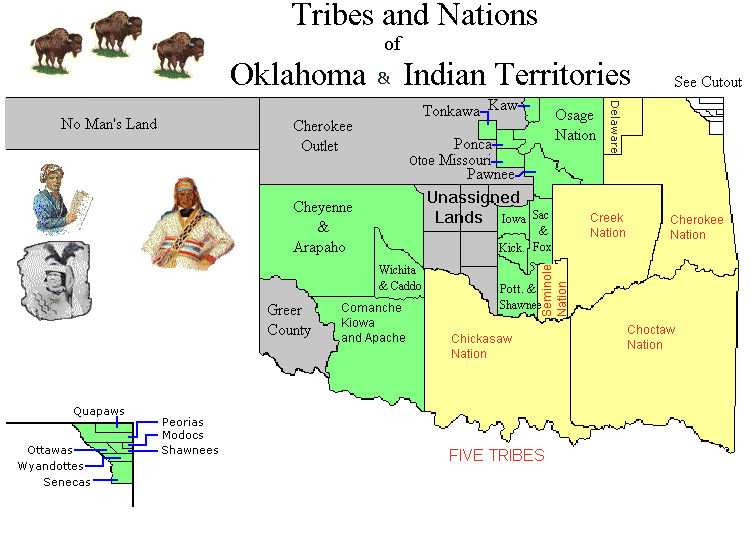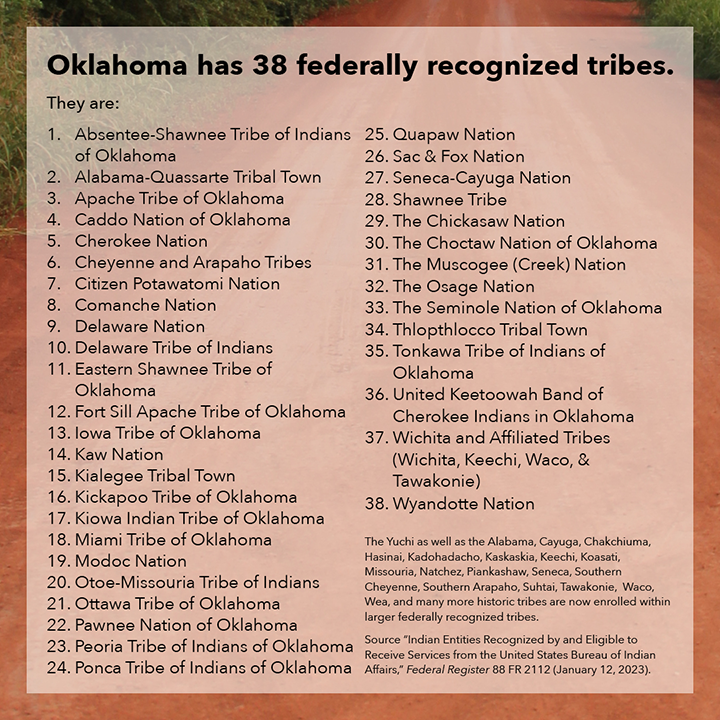Oklahoma’s Tribes: A Tapestry of Resilience and Tradition
Oklahoma’s Tribes: A Tapestry of Resilience and Tradition

Oklahoma. The name conjures images of vast prairies, rolling hills, and a rich history steeped in Native American culture. But beneath the surface of this beautiful state lies a vibrant tapestry of 39 federally recognized tribes, each with its own unique story, traditions, and spirit.
From the Cherokee Nation, the largest tribe in the state, to the smaller, lesser-known tribes like the Caddo Nation, Oklahoma’s tribal communities are a testament to resilience, adaptation, and the enduring power of heritage. Their story is one of forced migration, survival, and ultimately, a journey towards self-determination and cultural revival.
Related Articles: Oklahoma’s Tribes: A Tapestry of Resilience and Tradition
- Unveil the Rich Tapestry of Native American Tribes in Washington State
- Beyond The Stereotypes: Exploring The Rich Culture Of Indian Reservations Near You
- Unveiling the Rich Tapestry of American Indian Tribes in West Virginia
- Unveil the Enchanting World of the Indian Reservation in Buffalo, New York
- California’s Native Legacy: Exploring The State’s Reservations
A Legacy of Resilience: The Trail of Tears and Beyond
The history of Oklahoma’s tribes is intimately intertwined with the tragic events of the Trail of Tears. In the 1830s, the U.S. government forcibly removed thousands of Native Americans from their ancestral lands in the Southeast, forcing them to walk hundreds of miles to what was then known as Indian Territory. This brutal journey saw countless deaths from disease, starvation, and exposure.
Despite the hardships, the tribes persevered, establishing communities and rebuilding their lives in this new land. They adapted to the unfamiliar environment, cultivated the land, and fought to preserve their languages, traditions, and cultural identities.
Beyond the Trail: A Tapestry of Diversity
Oklahoma’s tribal landscape is incredibly diverse, with each tribe boasting a unique history, language, and cultural practices.
The Five Civilized Tribes:
- Cherokee Nation: Known for their strong sense of community and their contributions to education and healthcare, the Cherokee Nation is the largest tribe in Oklahoma. Their rich cultural heritage is evident in their language, storytelling, and traditional arts.
- Chickasaw Nation: The Chickasaw Nation is renowned for its innovative spirit, focusing on economic development and self-sufficiency. They are also known for their beautiful traditional dances and their commitment to preserving their language.
- Choctaw Nation: The Choctaw Nation, known for their strong tribal identity and their commitment to cultural preservation, has a rich history of storytelling, music, and dance.
- Creek Nation: The Creek Nation is known for its strong sense of community and its commitment to education. They are also known for their beautiful traditional crafts and their unique language.
- Seminole Nation: The Seminole Nation, known for their resilience and their strong sense of self-determination, has a rich history of resistance and survival. They are also known for their unique language and their contributions to the arts and culture.


Other Notable Tribes:
- Muscogee (Creek) Nation: The Muscogee Nation is one of the largest tribes in Oklahoma, with a rich history of storytelling, music, and dance. They are also known for their beautiful traditional crafts and their unique language.
- Osage Nation: The Osage Nation is known for its wealth and its strong sense of community. They are also known for their beautiful traditional crafts and their unique language.
- Comanche Nation: The Comanche Nation is known for its strong warrior tradition and its unique language. They are also known for their beautiful traditional crafts and their contributions to the arts and culture.
- Caddo Nation: The Caddo Nation is one of the oldest tribes in Oklahoma, with a rich history of storytelling, music, and dance. They are also known for their beautiful traditional crafts and their unique language.

A Modern Renaissance: Cultural Preservation and Economic Development
Today, Oklahoma’s tribes are thriving, embracing their cultural heritage while simultaneously forging a path towards economic self-sufficiency and political empowerment.
Preserving the Legacy:
- Language Revival: Many tribes are actively working to revitalize their languages, which were once suppressed by the U.S. government. Through immersion programs, language classes, and cultural events, they are ensuring that these vital parts of their heritage are passed on to future generations.
- Cultural Centers: Tribal museums, cultural centers, and art galleries showcase the vibrant traditions, artistry, and history of each tribe. These spaces serve as hubs for cultural education, preservation, and celebration.
- Tribal Casinos: While not without controversy, tribal casinos have played a significant role in the economic development of many Oklahoma tribes. The revenue generated by these casinos has allowed tribes to invest in education, healthcare, and other essential services for their members.
Economic Empowerment:
- Tribal Businesses: Many tribes are developing their own businesses, ranging from energy production to tourism and hospitality. These ventures provide jobs and economic opportunities for tribal members and contribute to the overall economic well-being of their communities.
- Tribal Governance: With growing self-determination, many tribes are taking control of their own destinies, enacting their own laws and governing their own affairs. This has led to a greater sense of autonomy and empowerment for tribal communities.
A Future of Collaboration:
As Oklahoma’s tribes continue to thrive, they are increasingly collaborating with each other and with the state government to address shared concerns and to build a stronger future for all Oklahomans.
Beyond the Headlines: The Human Story
The stories of Oklahoma’s tribes are not just about historical events or economic development. They are about the lives of real people, their struggles, their triumphs, and their enduring spirit.
- Elderly Storytellers: Their eyes sparkle with wisdom and their voices carry the weight of generations as they share stories of their ancestors, their traditions, and their resilience.
- Young Artists: They are breathing new life into ancient traditions, expressing their creativity through contemporary art forms, and ensuring that their culture remains vibrant and relevant.
- Community Leaders: They work tirelessly to improve the lives of their people, advocating for their rights, and building a brighter future for their communities.
Beyond the Statistics: A Call to Action
The story of Oklahoma’s tribes is a powerful reminder of the importance of cultural preservation, the resilience of the human spirit, and the ongoing struggle for equality and justice.
It’s a story that calls for understanding, respect, and a commitment to learning from the past and building a better future together.
FAQ about Oklahoma’s Tribes
Q: How many federally recognized tribes are in Oklahoma?
A: There are 39 federally recognized tribes in Oklahoma.
Q: What are the Five Civilized Tribes?
A: The Five Civilized Tribes are the Cherokee, Chickasaw, Choctaw, Creek, and Seminole Nations.
Q: Why are they called the Five Civilized Tribes?
A: They were called the Five Civilized Tribes because they had adopted many aspects of European culture, including agriculture, written language, and government systems.
Q: What is the Trail of Tears?
A: The Trail of Tears was the forced removal of thousands of Native Americans from their ancestral lands in the Southeast to Indian Territory (now Oklahoma) in the 1830s.
Q: What are some of the challenges facing Oklahoma’s tribes today?
A: Some of the challenges facing Oklahoma’s tribes today include poverty, lack of access to healthcare, and the loss of traditional languages.
Q: What are some of the successes of Oklahoma’s tribes?
A: Some of the successes of Oklahoma’s tribes include economic development, cultural preservation, and self-governance.
Q: How can I learn more about Oklahoma’s tribes?
A: There are many resources available to learn more about Oklahoma’s tribes, including museums, cultural centers, websites, and books. You can also visit tribal communities and speak with tribal members directly.
Q: What can I do to support Oklahoma’s tribes?
A: You can support Oklahoma’s tribes by learning about their history and culture, visiting tribal businesses and attractions, and advocating for their rights. You can also donate to organizations that support tribal communities.

Closure
Thus, we hope this article has provided valuable insights into Oklahoma’s Tribes: A Tapestry of Resilience and Tradition. We thank you for taking the time to read this article. See you in our next article!